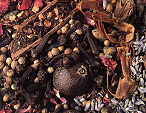Ten essential kitchen spices
Peppers, cloves and cinnamon are among the must-haves for any kitchen spice rack – keep them somewhere dark and cool, says Leslie Geddes-Brown


What is spice? I think I'll take Glynn Christian's dogmatic rule that herbs are green leaves and everything else?roots, bark, seeds, buds and flowers?are spices. Others try to say that spices are all exotic, but, although most of them are, European flavourings such as juniper, mustard, saffron and caraway are spices, too. And what about horseradish root, capers, sugar, olives, garlic and salt?
According to Elizabeth David, Britons have been passionately attached to exotic spices for more than 2,000 years, and, in the days of the East India Company
during the 17th and 18th centuries, London was the world centre of the spice trade. In 1747, Hannah Glasse produced a recipe for chicken 'currey', where chicken was spiced with turmeric, ginger and pepper. This was as nothing to 15th-century England, when 90% of meat and fish in rich houses would be spiced with ginger, pepper, mace, cloves, cinnamon and galangal, a variety of ginger. There was huge range of spices in general use 500 years ago.
What's more, modern historians doubt the myth that heavy-handed spicing was used to make rotten meat more edible?the current theory is that it was related to medieval medicine and the study of humours. Indeed, in Taste, Kate Colquhoun, writes that, if you want to sample medieval dishes, just go to Morocco.
Dedicated spice merchant Seasoned Pioneers (www.seasonedpioneers.com) has more than 200 spices and blends, with such rare offerings as Zanzibar Curry Powder, Tunisian Five Spice, Mandarin Peel, Epazote Leaves, File Powder and Long Pepper. It lists its spices by cuisine?Thai, African, South Indian, Mediterranean, Cajun?although, strangely, Northern European gets no look in. A shame, because what about seed cake, gin, cinnamon toast, gravadlax, mulled wine and British curry powder, brought from the Raj and sold ready-made from the 1830s?
Another spice merchant, Steenbergs (www.steenbergs.co.uk), has a list of 70 spices which does include European favourites such as juniper, dill, fennel and caraway seeds. But its bestseller is ras al-hanut, a Moroccan blend made from up to 30 different varieties and includes spices from all over the world: mace, cardamom, galangal, cubeb pepper, long pepper, orris root and, surprisingly, Spanish fly. It is £2.25 for a standard jar.
However, if you're off to Morocco this winter, get a spice merchant to make up his own ras al-hanut. Glynn Christian says that there should be up to 27 ingredients, including at least six pepper varieties, plus rosebuds and lavender flowers. Chilli, he says, should play no part. The mixture, he adds, gives 'a satin-smooth hit of hedonistic reward'. He stirs it into couscous or rice with butter and it's good with eggs.
Sign up for the Country Life Newsletter
Exquisite houses, the beauty of Nature, and how to get the most from your life, straight to your inbox.
Steenbergs is introducing a new American range of blends, such as Texas Chilli, Southwestern, Pumpkin Pie, Seafood and Southern Fried Chicken. Seasoned Pioneers, on the other hand, is introducing a mulled white wine mix (to complement its red wine mix) at £1.50, and a spice mix to add to tea, also very fashionable today. Both firms have online recipes, although, when I asked the Seasoned Pioneers website for a Thai main course of fish, I got a Mexican starter instead. Both websites are helpful about these abstruse mixtures.
But there's nothing like sampling spices in their own territory. Chilli in Mexico or Madrid; ginger and five-spice mix in China; Tabasco on every cafe table in New Orleans; fennel seeds in Tuscan salami; and Worcestershire sauce, not in Japan where it's a rave, but in Worcester in a Bloody Mary.
TEN ESSENTIAL SPICES
Pepper, cloves, cinnamon, nutmeg,
cardamom, chilli, mustard, paprika,
saffron and vanilla
TEN ALMOST ESSENTIALS
Allspice, ginger, caraway, fennel,
star anise, coriander seed, cumin,
turmeric, juniper and lemongrass
TEN BLENDS TO SAVOUR
Garam masala (India), ras-al-hanout (Morocco), quatre épices (France), Chinese five spice (China), baharat (Gulf States), curry powder (British Raj), dukkah (Middle East), harissa (Tunis), gomashio (Japan) and zahtar (Middle East)
Storing spices
Keep them in the dark and cool. If you have space in the fridge, keep ground spice and cardamom in it. Otherwise, have a grand throw-out in the New Year and buy new ones, in small quantities
Country Life is unlike any other magazine: the only glossy weekly on the newsstand and the only magazine that has been guest-edited by HRH The King not once, but twice. It is a celebration of modern rural life and all its diverse joys and pleasures — that was first published in Queen Victoria's Diamond Jubilee year. Our eclectic mixture of witty and informative content — from the most up-to-date property news and commentary and a coveted glimpse inside some of the UK's best houses and gardens, to gardening, the arts and interior design, written by experts in their field — still cannot be found in print or online, anywhere else.
-
 'Monolithic, multi-layered and quite, quite magnificent. This was love at first bite': Tom Parker Bowles on his lifelong love affair with lasagne
'Monolithic, multi-layered and quite, quite magnificent. This was love at first bite': Tom Parker Bowles on his lifelong love affair with lasagneAn upwardly mobile spaghetti Bolognese, lasagne al forno, with oozing béchamel and layered meaty magnificence, is a bona fide comfort classic, declares Tom Parker Bowles.
By Tom Parker Bowles
-
 Country houses, cream teas and Baywatch: Country Life Quiz of the Day, April 24, 2025
Country houses, cream teas and Baywatch: Country Life Quiz of the Day, April 24, 2025Thursday's Quiz of the Day asks exactly how popular Baywatch became.
By Toby Keel